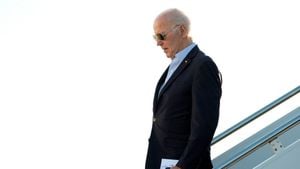U.S. inflation showed signs of mild acceleration as the Consumer Price Index (CPI) increased to 2.6% for October, marking the first uptick since March of this year. This announcement came from the U.S. Bureau of Labor Statistics, reporting inflation rose marginally from the previous month’s 2.4% rate, which had set the lowest benchmark experienced over the last three years.
The October inflation figure reflects both year-over-year changes and the month-over-month adjustments, with October's CPI exhibiting a 0.2% rise from September. Economists had largely anticipated this development, considering it aligned with their forecasts. The core CPI, which disregards volatile categories such as food and energy, remained unchanged and held firm at 3.3%, maintaining expectations as well.
Despite these numbers representing significant decreases since the historic highs encountered during the summer of 2022, inflation still stresses many Americans. Families across the country feel increasing pressure as the cumulative effects of rising prices have endured long-term ramifications on household budgets.
The Federal Reserve's decision to cut interest rates last month appears to be aimed at managing economic growth alongside mitigating inflationary impacts. The move came as the Fed aims to navigate complex economic terrain, where inflation goals remain slightly above the 2% target. Chair Jerome Powell stated there remains much work to do, asserting confidence in being on the right path toward achieving 2% inflation but acknowledging challenges loom.
Interestingly, certain categories like housing have noticeably contributed to inflation's resurgence. A sharp increase of 0.4% for housing prices accounted for over half of the monthly increase. The pandemic has left lasting effects on housing markets, driving up costs significantly. Various other sectors are grappling with increased insurance premiums and other essentials, aggravation the situation for consumers.
Meanwhile, political dynamics have also added complexity to the economic forecast. With Donald Trump’s recent victory, discussions around tax cuts and tariffs have returned to center stage, sparking debate on their potential impact on inflation moving forward. The Budget Lab at Yale raised concerns, estimating these tariffs might escalate inflation by as much as 5.1% if fully implemented, adding additional worry to the economic recovery efforts.
The recent election results indicated heightened dissatisfaction concerning the economy among voters. Many polled expressed frustration with rising costs and stagnant wages, signaling key challenges the new administration must tackle head-on.
Further complicate matters, the labor market reflected signs of slowing down, with just 12,000 jobs added during October, pushing the unemployment rate to 4.1%. Despite this still representing low rates comparable to pre-pandemic levels, it presents another layer to the Federal Reserve’s calculus as they aim to balance inflation management with labor market strength.
With the consumer price index on the rise, the coming months are expected to be pivotal for policymakers. The Fed's next moves will be closely watched, particularly as they relate to strategies for bringing inflation down without curtailing employment growth. The stakes remain high as the nation grapples with maintaining economic vitality amid persistent inflationary pressures and ever-shifting political landscapes.
Concerns about sustained inflation are evident, as trends suggest various household expenditures continuing to bloom, potentially dampening consumer confidence. While the economy seeks stability, everyone from experts to everyday Americans watches how all these intertwining factors shape the nation’s financial future.



